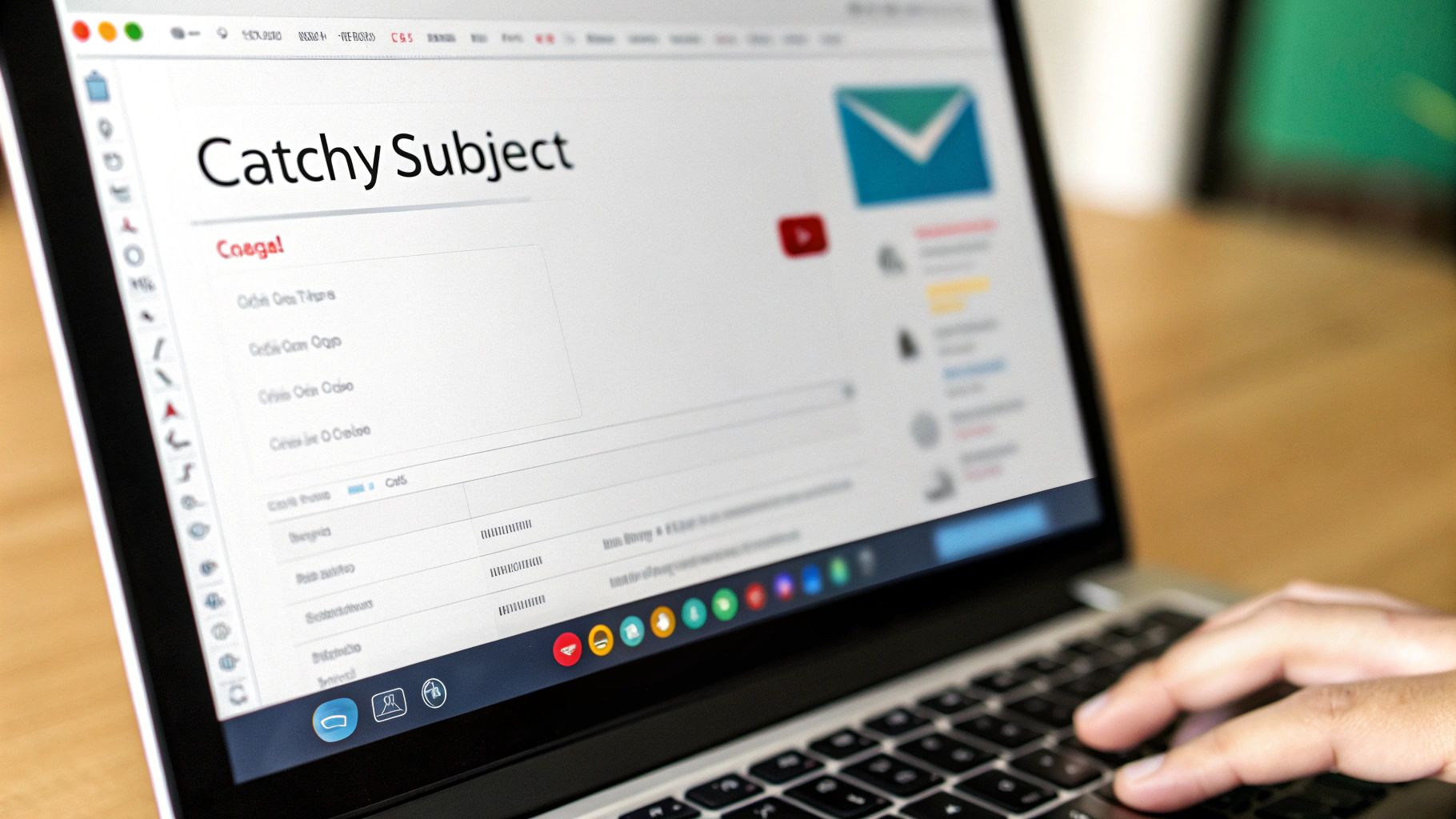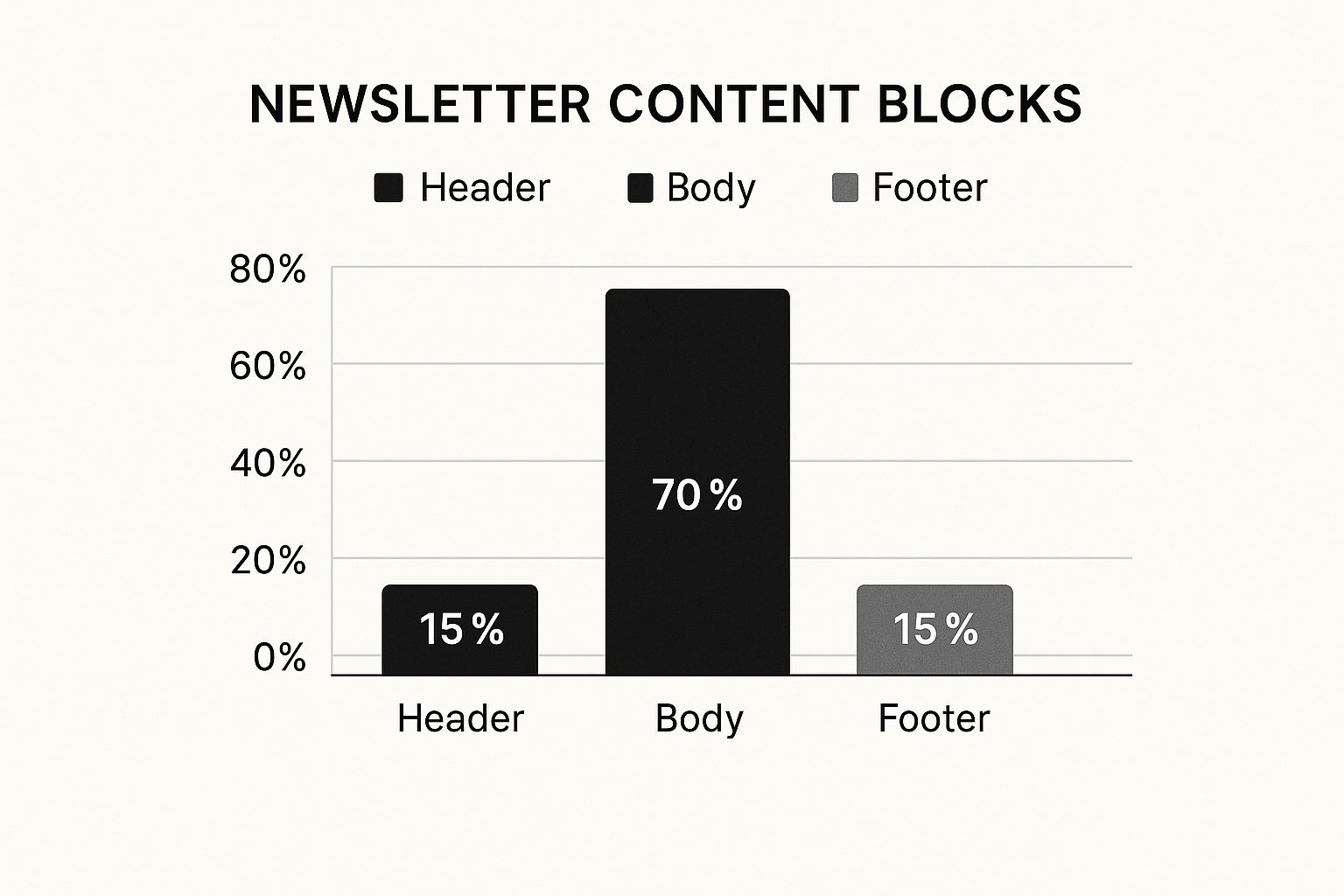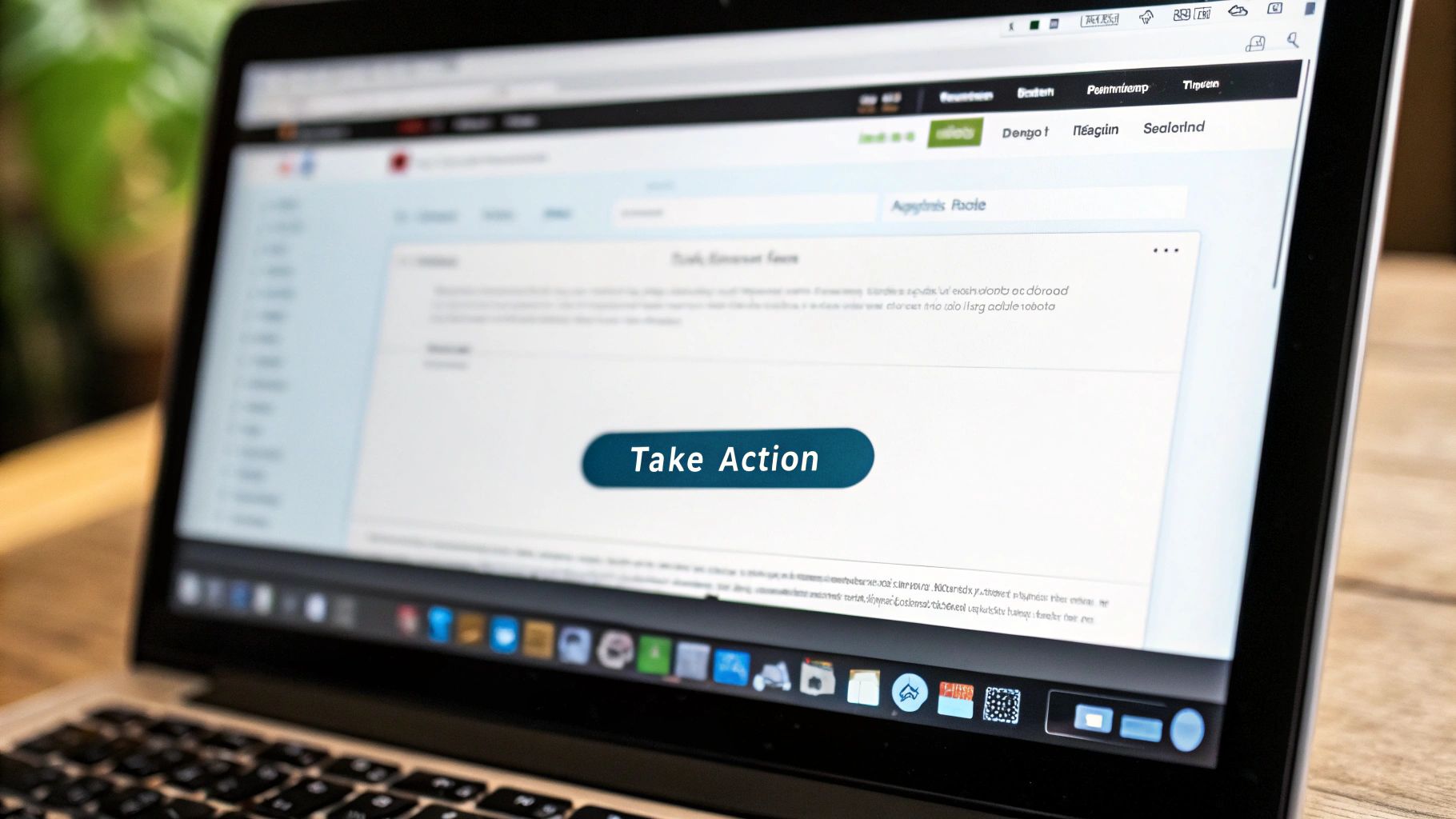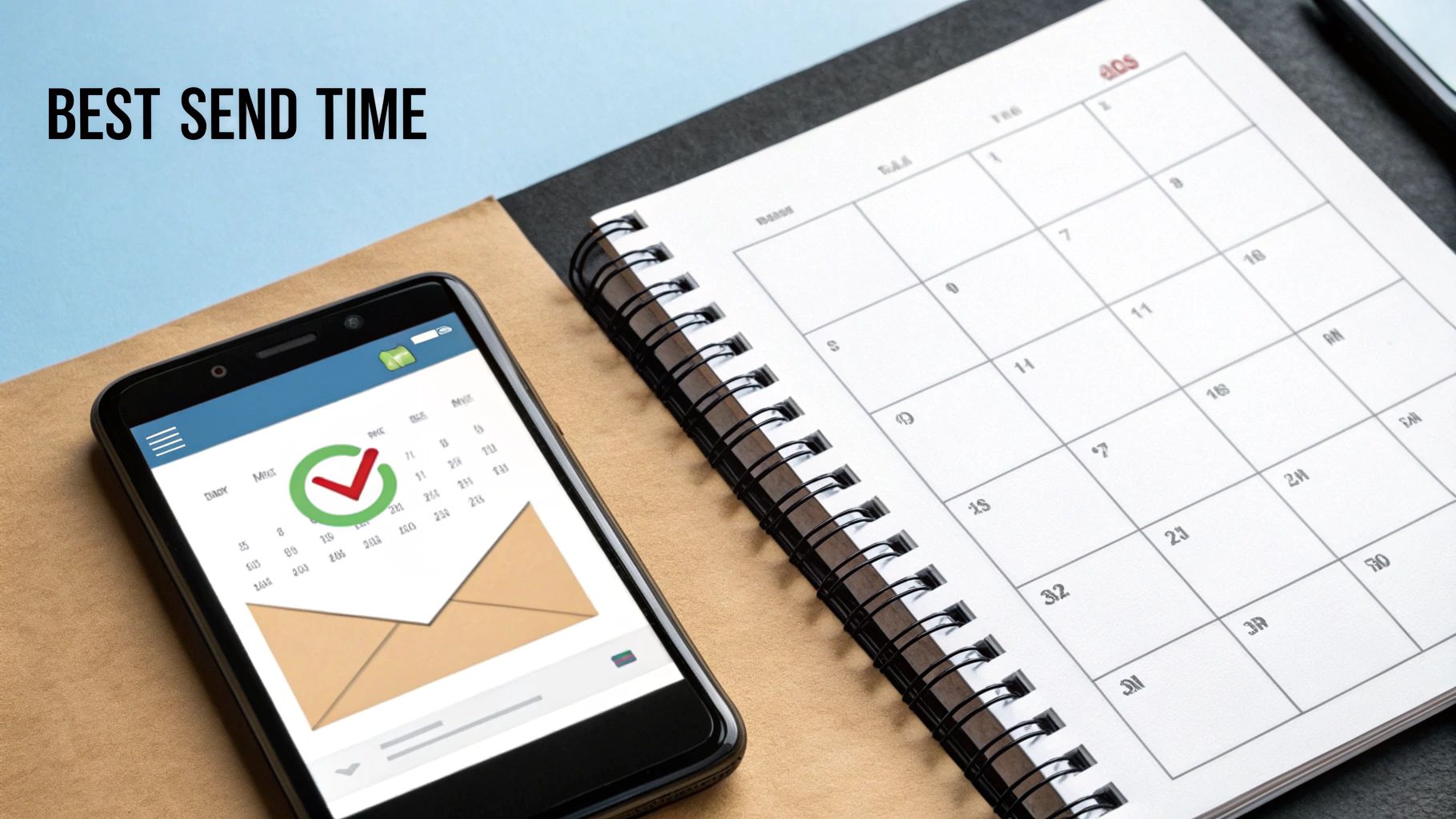So, you’re ready to create a newsletter. It really comes down to three things: figuring out your goal and who you’re talking to, creating a great-looking design, and then writing something people will actually look forward to reading.
Get these pieces right, and you’ll stop sending just another email and start creating a must-open event for your subscribers.
Laying the Groundwork for a Great Newsletter
Before you jump into writing catchy subject lines or designing the perfect call-to-action button, you have to build a solid foundation. Honestly, this planning stage is what separates the newsletters that get instantly deleted from the ones that build a loyal following.
It might not be the most exciting part, but trust me, skipping this step is a surefire way to get low open rates and watch subscribers disappear. Everything starts with one simple question: Why are you sending this in the first place?
What’s the Point? Define Your Goal
First things first, you need a single, clear goal. What are you actually trying to achieve here?
Maybe you want to drive sales for your online shop. Or perhaps your aim is to become a recognized expert in your field. It could even be about building a community around your brand. Each of these goals needs a totally different approach. A sales-focused newsletter is going to be full of product highlights and exclusive discounts, while a community-building one might feature member stories and upcoming events.
Get to Know Your Audience (Really Know Them)
Next up, you have to go deeper than surface-level demographics. Who are you really writing for? Don’t just think "moms in their 30s." Instead, think about their specific struggles, their hopes, and what they need help with.
For example, a newsletter for new parents shouldn’t just offer generic parenting advice. It should tackle the real stuff, like dealing with sleep deprivation or finding five minutes of peace. When you understand what keeps your audience up at night, you can create content that genuinely helps them.
My two cents: A newsletter that works either solves a problem, offers real value, or builds a genuine connection. If yours isn't doing at least one of these, it's just more noise in an already-crowded inbox.
Choosing Your Email Toolkit
Finally, you’ll need an Email Service Provider, or ESP. This is the platform you’ll use to actually send your campaigns. There are tons of options out there, from free tools perfect for getting started to powerful systems with all the bells and whistles.
Think about your budget, how comfortable you are with technology, and where you see this newsletter going. It can be tempting to just use Gmail or Outlook, but an ESP is essential for making sure your emails actually land in the inbox and for staying on the right side of the law.
If you want to dig deeper into the world of email platforms and strategy, I’ve got a lot more expert tips on email marketing you can check out.
Designing a Visually Compelling Newsletter

Think about your own inbox for a second. It's crowded, right? When an email lands, its design is the very first thing you notice, and it's what makes you decide to either read on or hit delete.
Good design isn't about throwing in a bunch of flashy graphics. It’s about creating an experience that's clean, professional, and dead simple to navigate. This is especially true when you consider that over 50% of emails are now opened on a phone.
The real secret is to design for scannability. Your newsletter should act like a roadmap, guiding the reader’s eye with clear headings, short paragraphs, and lots of white space. This makes your content feel approachable and helps your most important points stand out.
Building a Cohesive Brand Look
Your newsletter shouldn't feel like it came from a stranger. It needs to look and feel like an extension of your website, creating a sense of familiarity that builds trust. Start by sticking to a simple, on-brand color palette—two or three main colors is all you need.
Fonts are another piece of the puzzle, and readability is everything.
- For headings: A clean, bold font like Lato or Montserrat does the trick.
- For body text: You can't go wrong with classics like Open Sans or Georgia. They were designed for on-screen reading and are easy on the eyes.
If you're struggling to get all your digital assets to look unified, it might be worth exploring how to choose a web design agency to help you pull it all together.
Using Visuals That Help, Not Hinder
Images and GIFs are brilliant for breaking up long blocks of text and adding a bit of personality. But—and this is a big but—they have to support your message without slowing your email to a crawl. Oversized image files are a classic mistake that can send your bounce rates soaring.
Key Takeaway: Always, always optimize your images. Keep the file size under 1MB to make sure your newsletter loads quickly, even on a spotty connection. A gorgeous design is worthless if nobody sticks around long enough to see it.
At the end of the day, every visual element, from where you place your logo to the color of your call-to-action button, should work together. The goal is to create a seamless journey that guides your subscriber right to the action you want them to take.
Crafting Content That Connects and Converts
With your design sorted, it’s time to focus on what really matters: the words. Your content is the soul of your newsletter. It's how you build trust, deliver real value, and gently guide subscribers toward taking action. The goal is to make every email feel less like a mass marketing blast and more like a helpful, personal note from a trusted expert.
This all begins with the subject line. This tiny snippet of text is your single biggest lever for getting someone to actually open your email. Forget generic phrases. Instead, aim to spark some curiosity. Try something like, "Your Weekly Dose of [Benefit]" or ask a direct question, "Are You Making This Common [Industry] Mistake?"
Finding Your Unique Voice
What makes your newsletter stand out is your unique voice. Are you the witty, informal friend, or the straightforward, authoritative guide? Whatever you land on, stick with it. Consistency is key. That authenticity is what makes subscribers feel like they actually know the person or brand on the other side of the screen, building a much stronger connection.
To keep your audience engaged week after week, you need to mix things up. Sending the same promotional update every time is a surefire way to land in the trash folder.
- Share a personal story that ties into a lesson you’ve learned in your industry.
- Offer a behind-the-scenes look at how you create a product or manage a new project.
- Curate a list of genuinely useful resources—articles, tools, or podcasts you've found valuable.
- Interview another expert in your field and pull out their most actionable insights for your readers.
If you’re looking for a solid foundation, leveraging effective lead nurturing email templates can give you a great starting point for structuring emails that provide value first and foremost.
The Power of Personalization and Smart Structure
Making your subscribers feel seen is a game-changer. It’s no surprise that emails with personalized subject lines are 26% more likely to be opened. Even better, personalized calls to action have been shown to convert a staggering 202% better than generic ones.
Even something as simple as using a subscriber's first name can have a huge impact on how they engage with your content.
When it comes to the email itself, structure is everything. I like to think of a newsletter in three distinct parts: the header, the body, and the footer. But they aren't all created equal. This visual breaks down where your focus should be.

The takeaway is clear: while the header and footer are necessary for branding and the boring legal stuff, the body is where the magic happens. It’s where you deliver on your promise.
Key Insight: Always remember that your subscribers' time is their most valuable asset. Get straight to the point using the inverted pyramid model. Lead with your most important message or offer right at the top, then fill in the supporting details for those who want to learn more. This approach respects their attention and dramatically increases the odds they’ll actually do what you’re asking.
Newsletter Content Idea Matrix
Stuck on what to write about? This matrix can help you brainstorm fresh ideas by matching your goals with different content types and then applying them to your specific industry.
| Content Goal | Content Type Idea | Example for a Fitness Brand | Example for a B2B SaaS |
|---|---|---|---|
| Build Authority | How-To Guide or Tutorial | "5 Foam Rolling Moves to Prevent Injury" | "Step-by-Step Guide to Integrating Our API" |
| Drive Engagement | Ask a Question / Run a Poll | "What's your biggest fitness struggle right now? Reply and let us know!" | "Vote for Our Next Feature: Which Integration Should We Build?" |
| Nurture Leads | Customer Case Study | "See How Sarah Lost 20 lbs with Our Meal Plan" | "How Company X Increased Productivity by 40% with Our Software" |
| Promote a Product | Behind-the-Scenes Look | "A Sneak Peek at Our New Line of Sustainable Yoga Mats" | "Watch Our Head of Product Demo the New Dashboard" |
Use this framework as a jumping-off point. The key is to consistently provide a mix of content that serves different purposes, keeping your newsletter valuable and interesting over the long haul.
Growing Your Subscriber List Authentically

You can have the best-looking newsletter with incredible content, but it's all for nothing if your send list is empty. Building an audience is where the real work begins, and it’s always about quality, not just quantity. The aim isn't to hoard email addresses; it's to connect with people who are genuinely eager to hear what you have to share.
One of the best ways I’ve found to do this is by creating a compelling lead magnet. This is a valuable freebie you offer in exchange for an email. Don’t just throw together a generic checklist. Think bigger. Could you create an exclusive video tutorial, a 5-day email mini-course, or a detailed template that solves a real problem? The trick is to offer something so undeniably useful that giving you their email feels like a steal.
The creator economy is booming for a reason. In 2024 alone, platforms like beehiiv sent a staggering 15.6 billion emails, representing a 96.2% jump in hosted newsletters from the previous year. This isn't just a trend; it's a massive shift showing that independent creators are building real, sustainable audiences.
Where to Place Your Sign-Up Forms
Once your killer lead magnet is ready, you need to make it incredibly easy for people to get it. Your website is the most valuable piece of real estate you own for this. You have to be strategic about where you place your sign-up forms to catch visitors when they're most interested.
Here are a few high-impact spots I always recommend:
- Your Homepage: Put a clear call-to-action right at the top, "above the fold."
- Blog Posts: Add a sign-up form at the end of every article, catching readers when they're hungry for more.
- Footer: A simple sign-up field in the footer of every page is a must.
- About Page: Visitors on this page are already curious about you. It's the perfect time to invite them to connect.
Building a website with these conversion points baked in from the start is a game-changer. If you’re just getting started, learning how to build a website that’s designed to capture leads is a smart first step.
Key Takeaway: Whatever you do, never buy an email list. It’s a surefire way to land in the spam folder, destroy your sender reputation, and break any trust you might have built. Slow, authentic growth is always better—it creates a foundation of subscribers who actually want your emails.
Lastly, don’t forget to practice good list hygiene. This is just a fancy way of saying you should regularly clean up your list by removing subscribers who haven’t opened your emails in months. I know it feels wrong to shrink your numbers, but it pays off by massively improving your deliverability rates. You'll end up with a smaller, more engaged audience, which is exactly what you want. Brushing up on proven email list management strategies is a great way to master this part of the process.
Using Analytics to Improve Your Newsletter
Hitting ‘send’ on your newsletter isn't the finish line. Honestly, it’s just the beginning—this is where you start making smarter decisions for next time. Your email analytics are a goldmine of feedback, showing you exactly what your subscribers are actually paying attention to.
Learning to read this data is the secret to creating a newsletter that gets better with every single send. Don’t let the jargon intimidate you. Most of what you need to know boils down to just a handful of key metrics that tell a story about your newsletter's health.
Key Metrics That Actually Matter
Think of your analytics dashboard as a direct line to your audience. Here’s a quick rundown of what they’re telling you:
- Open Rate: This is the percentage of people who opened your email. It's your most direct report card on how well your subject line worked. A low open rate usually means the subject line didn't grab them.
- Click-Through Rate (CTR): This tracks how many of the people who opened your email actually clicked on a link. A strong CTR tells you the content inside was compelling enough to get them to take the next step.
- Unsubscribe Rate: The percentage of people who opted out after receiving this email. A few unsubscribes with every send is totally normal, but a sudden spike is a massive red flag that something is off with your content or sending frequency.
Email continues to be an incredibly effective channel. Some studies show an estimated $36 returned for every $1 spent. But those returns don't just happen; they're the result of using data to segment audiences and personalize content.
For a bit of perspective, benchmark open rates on popular platforms often fall somewhere between 19% and 23%. You can dig deeper into email statistics and performance on blog.cloudhq.net to see how you stack up.
Put Your Data to Work with Simple Tests
The real magic happens when you use analytics to actively improve. This is where A/B testing—sometimes called split testing—becomes your best friend. The idea is simple: you send two slightly different versions of your email to a small slice of your audience and see which one performs better.
Pro Tip: Start with your subject lines. They're easy to test and have a huge impact. Try sending one that's a straightforward statement and another that asks a question. Most email platforms can automatically send the winning version to the rest of your list.
You can test almost anything—your send time, the color of a call-to-action button, or even the layout of your content. By making one small, measurable change at a time, you build a powerful feedback loop that lets you consistently refine and improve your newsletter.
Got Questions? We've Got Answers

Even with a solid game plan, you're bound to have some questions as you dive into the world of email newsletters. That's perfectly normal. Let's walk through some of the most common hurdles so you can feel confident every time you hit "send."
How Often Should I Actually Send This Thing?
This is the big one, isn't it? The perfect sending frequency is less about a magic number and more about what you can realistically commit to without sacrificing quality. A rushed weekly email filled with fluff will do more harm than a well-crafted monthly newsletter your audience genuinely looks forward to.
Start with a schedule you know you can nail, whether that's weekly, bi-weekly, or once a month. Being dependable is how you build anticipation and trust.
Key Takeaway: It's all about consistency over frequency. Keep an eye on your open rates and unsubscribes—your audience will tell you if you’ve found the right rhythm. Don't be afraid to tweak your schedule based on that data.
Is There a "Magic" Day and Time to Send Emails?
You've probably seen articles claiming Tuesday at 10 a.m. is the golden hour for email. The real answer? It completely depends on your audience and their daily routines. There’s no universal “best” time.
Think about who you're talking to and what their day looks like.
- B2B Audience: If you’re sending to corporate professionals, a weekday morning like Tuesday at 9 a.m. often works well as they settle in at their desks.
- Parenting Blog: Sending an email to busy parents? Try 8 p.m. on a weeknight after the kids are finally asleep.
The only way to find your sweet spot is to experiment. Use the analytics in your email platform to test different days and times. The data will show you what truly resonates with your subscribers.
How Can I Keep My Emails Out of the Spam Folder?
Landing in the inbox instead of the spam folder boils down to your sender reputation. The number one rule is simple but non-negotiable: never, ever buy an email list. Always, always get permission from people before you email them.
Beyond that, a few technical steps make a huge difference. Use a well-regarded email service provider and make sure you authenticate your domain. This is like showing your ID at the inbox door—it proves you are who you say you are.
Also, avoid classic spam triggers in your subject lines, like writing in ALL CAPS or using a million exclamation points!!!
Finally, practice good list hygiene. Every few months, it's smart to clean out subscribers who haven't opened your emails in a long time. This signals to email clients like Gmail that you’re sending relevant content to an engaged list, which seriously boosts your deliverability.
Ready to build a newsletter that not only looks great but also drives real results? Sugar Pixels offers complete web design and email marketing services to help your brand connect with customers. Let's create something your audience will love. Learn more at sugarpixels.com.